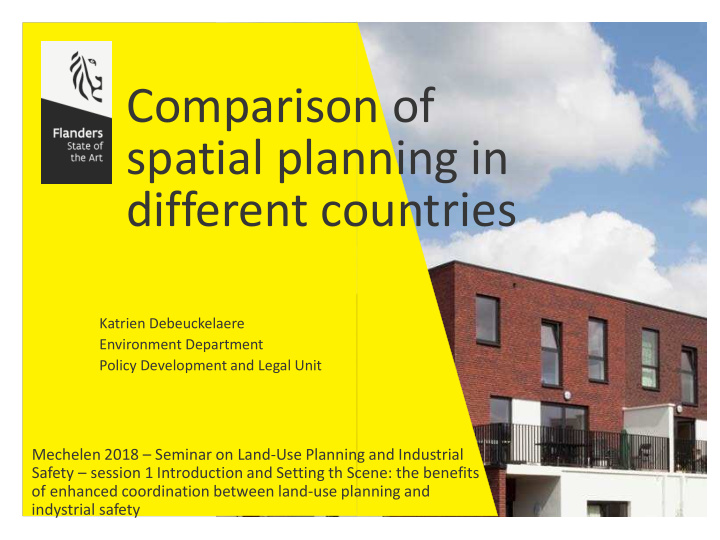



Comparison of spatial planning in different countries Katrien Debeuckelaere Environment Department Policy Development and Legal Unit Mechelen 2018 – Seminar on Land-Use Planning and Industrial Safety – session 1 Introduction and Setting th Scene: the benefits of enhanced coordination between land-use planning and indystrial safety
Spatial planning – land-use planning Definition: Spatial planning aspires to be an interdisciplinary and cross-cutting coordinator of sectoral policies and decisions with spatial impacts, including those concerned with the environement, infrastructure and regional economic promotion. It is generally institutionally anchored on at least two spatial levels (municipal and national). In addition, there are greatly varying forms of organization on the regional planning level in different countries. Reimer M., Getimis P., Blotevogel H.H. (2014) Spatial planning systems and practices in Europe; A comparative perspective on continuity and changes, Routledge, New York, p. 1.
Spatial planning is about zoning for 28/05/2018 │ 3
28/05/2018 │ 4
28/05/2018 │ 5
28/05/2018 │ 6
28/05/2018 │ 7
28/05/2018 │ 8
(land-use) planning Different approaches to land-use planning In most countries: a policy document/plan at national level A land-use plan at municipal level Examples of land-use planning systems in Europes which result from a study conducted for Flanders: “Concepts for the framework and adaptation of several instruments in the implementation phase of a (spatial) planning process”, 2015
Integration of safety concerns in land- use planning Transboundary consultation in land- use planning Were explicitly introduced into the land-use planning legislation in 2016
Characterics of the integrated planning process INTEGRATION: Integration means iterative processes: safety and planning and participation and other feasible assessments Multidisciplinary planning team: spatial planners, and sectoral experts Integration starts from the beginning of the process: kick-off document evolving to a scoping document Continuous quality controll of the assessments
Integrated planning process (land-use plan and industrial safety) Kick-off document (stakeholders - decisions Process description document First formal participation moment 60 days Scoping document (includes screening/scoping industrial safety) Draft land-use plan and draft safety report Second participation 60 days Final Land-use Plan and safety report
Changing attitude: a bumpy road... Different sectors use a different language => explain to each other the meaning of certain concepts From sectoral approach to team work A new role for the industrial safety unit (regional level): from controlling to co-operating and knowledge centre Provinces and municipalities work in co-operation with the regional level.
Conclusion Each country has its own land-use planning system A land-use policy plan is made in several countries A policy plan is, in general, made for a larger geographical area than a land-use plan Land-use plans tend to be rather comprehensive for all activities including industrial zones It integrates different demands and concerns A land-use plan is (should be) sthe result of a mulidisciplinary approach Transboundary consultation, information and participation is important if not crucial in certain cases
Thank you for your attention katrien.debeuckelaere@vlaanderen.be omgevingvlaanderen.be
Recommend
More recommend